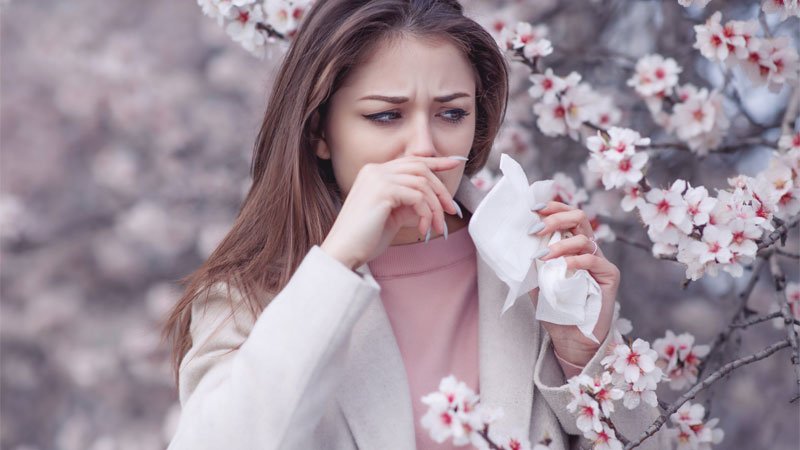Allergies are on the increase (particularly in the Western world) with the UK having some of the highest prevalence rates of allergic conditions in the world. It is thought that a staggering 44% of British adults now suffer from at least one allergy, and that almost half (48%) of sufferers have more than one allergy (Mintel, 2010).
Experts aren’t quite sure why allergies are increasing, but some of the main theories include:
- The hygiene hypothesis – our obsession with cleanliness that means we are less exposed to infections or microbes in early life, resulting in a more reactive immune system
- Climate change
- Air pollution
- Dietary changes
- Delayed introduction of allergenic foods such as peanuts, until later in childhood
- Vitamin D deficiency
- Overuse of antibiotics
Allergy is the most common chronic disease in Europe with experts predicting that half of the entire EU population will suffer from an allergic disease by 2025 (EAACI, 2016).
As it’s Allergy Awareness Week this month we thought it might help to provide some tips on how essential oils can support allergy sufferers to make life that little bit easier!
What is an allergy?
According to Allergy UK an allergy is “the response of the body”s immune system to normally harmless substances, such as pollens, foods, and house dust mite. Whilst in most people these substances (allergens) pose no problem, in allergic individuals their immune system identifies them as a ‘threat’ and produces an inappropriate (or allergic) response”.
The most common causes of allergic reactions are:
- Grass and tree pollen
- Dust mites
- Animal dander (hair / skin particles)
- Foods
- Insect bites and stings
- Medications
- Latex
- Mould
- Chemicals
When a person with a sensitivity comes into contact with an allergen their immune system starts to make antibodies to attack it. This ‘over-reaction’ can cause a variety of symptoms which include:
- Sneezing
- Itchiness
- Runny or blocked nose
- Red, watering eyes
- Skin reactions – dry, red, cracked, rashes
- Stomach problems – pain, sickness or diarrhoea
- Chest problems – cough, wheezing, tightness, shortness of breath
- Swelling
- Anaphylaxis
NOTE: Anaphylaxis is a severe allergic reaction and needs urgent medical attention. Make sure you always call a medical professional if you are experiencing rapid onset of an itchy rash, throat or tongue swelling, breathing difficulties, shortness of breath, vomiting, light-headedness, clamminess, confusion, low blood pressure or collapse.
As well as the physical symptoms listed above, it can also be quite mentally distressing when you suffer with an allergy, especially if it becomes chronic.
Aromatherapy and allergies
Of course, we know that essential oils are natural chemicals that can help to balance our bodies – and our minds – so, what better way to support your suffering with this particular type of physical issue, than with aromatherapy?
Essential oils that help with immunity, inflammation and irritation are particularly useful, as well as those that can help to detoxify the body and give us a general boost, so our susceptibility to allergens is reduced.
Our top ten essential oils for allergies
Here’s a run-down of the oils that are most likely to help, but first it is super important, when suffering with allergies, that you do a patch test first, just to make sure you don’t have an allergy to the oils you want to use.
Patch test
To do a patch test mix 1 drop of any oil from the list below with 5ml of Grapeseed oil and pop a bit on the skin just behind your ear. Leave it for half an hour and if there’s no reaction, you are good to go!
Now that’s sorted, let’s take a look at the best oils and their beneficial properties.
Oils for immunity
As we’ve discussed above allergies are caused by an overactive immune response, so here are some of the best oils that can help balance and calm your immune system – helping you to overcome the cause of your allergy.
Lemon – having an affinity for the immune system, Lemon is often described as an immune-stimulant, and although we don’t want that as the immune system is already over-sensitive, essential oils that have an affinity with something are likely to balance that system too. Lemon can strengthen our immunity so that it is reminded what it is meant to be doing, so it’s a nice oil to add to an allergy blend.
Sweet Orange – supporting immune system function, again this is a nice, calming essential oil to help remind the body what it is meant to be doing in its immune response, whilst also keeping us relaxed.
Lemongrass – again, wonderful for the immune system, Lemongrass is also a tonic for the nervous system, for those of you who are feeling stressed. When you’re stressed your body releases hormones that can make allergic reactions worse.
Lavender – aiding both immunity and inflammation, Lavender is an all-round allergy tonic – and it is de-stressing too, so it’s great for blends trying to address all three problems!
Oils for inflammation
One of the body’s responses to allergic reactions is inflammation. So, when selecting oils to use in creating your blends, it’s important to throw some of these in, to help overcome the symptoms of allergy.
Peppermint – this oil is a wonderfully cooling, soothing oil for inflammation. It has a particular affinity for the digestive system, but is also great for respiratory symptoms and for soothing itchy, irritated, inflamed skin.
Basil – another oil with an affinity for the respiratory system, this oil also helps with digestive inflammation, and is well known for any head symptoms.
Eucalyptus – great for bites and stings, this oil is perhaps better known for its respiratory and immune system support. It is also an expectorant and can help rid toxins from the body.
Tea Tree – as well as being anti-inflammatory, this oil can destroy pathogens that cause allergies, such as mould, bacteria and fungi. It is also great for the skin and boosting the immune system.
Oils for irritation
Again, in response to inflammation our bodies can also feel irritated e.g. our skin, digestive system, sinuses or nasal passages. Here are a couple more useful oils that are great for soothing and calming things down!
Chamomile – perhaps one of the most soothing, calming and balancing oils for physical irritation (and mental!). Known for its reduction of histamine-related reactions, it is excellent for supporting with problems such as hay fever, asthma and eczema.
Sandalwood – is soothing and balancing and generally calming. It is particularly good for skin and respiratory issues.
How to use essential oils for allergies
So, now we know which oils can help, you might be wondering how to use them? Here are some of the most useful methods, along with some recommended blends:
Blending methods
One of the beautiful things about essential oils is that they are really easy to get into the blood-stream. You don’t have to even apply them topically to the skin for them to have an effect, so if you are feeling that you just don’t want to apply anything to your body, you can easily use another method. Here are some suggestions:
- Allergy diffusion: mix up to 7 drops (total) of your favourite 3 essential oils in a candle burner or electrical diffuser and diffuse for up to 30 minutes at a time, each day to remind your body of its normal responses.
- Immunity spritz: for respiratory or skin issues create a spritz by mixing your choice of up to 30 drops (total) of 3 essential oils in 100ml Lavender hydrolat or water and use it as a spray for when you’re feeling in need of symptomatic relief.
- Skin soother: to apply topically for irritated skin, blend your choice of 3 soothing essential oils – mix up to 4 drops (total) in 15ml carrier oil such as Grapeseed oil – patch test this blend behind your ear and if all is okay, you may apply topically. A great ‘soothing’ skin blend is below, and we would recommend sticking to this on your first attempt to see how your inflamed skin reacts before experimenting with other oils.
- Steam Inhalation: for respiratory relief, you could try a steam inhalation. Mix up to 8 drops (total) of your choice of 3 oils in a bowl of warm water, pop a towel over your head, close your eyes and lean over so you can inhale the steam. Steam inhalations should be used with care when suffering with allergies. If you haven’t used this method before, inhale for only 30 seconds the first time to test for any negative reaction. If all is OK, inhale for 1 minute the next time, building gradually to 3-5 minutes.
- Inhaler: for support on the go, pop up to 3 drops of your chosen oils into an aromatherapy inhaler and sniff regularly as required.
Top 5 Allergy Blends
Of course, if you don’t want to experiment with your own blends we have some recommendations on what works well for some of the most common allergies.
- Hay fever diffusion: Diffuse 3 drops Lavender, 2 drops Chamomile and 1 drop Tea Tree in an aromatherapy diffuser or candle burner for up to 30 minutes a day.
- Immunity balancer: all allergies could benefit from an immunity boosting spritz, so try mixing 15 drops Sweet Orange, 10 drops Lemongrass and 5 drops Peppermint in 100ml of Lavender Hydrolat and spritz over yourself throughout the day!
- Skin Soother: to calm irritated and inflamed skin, be gentle and try 2 drops Lavender, 1 drop Chamomile and 1 drop Sandalwood mixed in 15ml Grapeseed oil, and gently massage into the affected area, after a patch test, in a direction towards the heart.
- Respiratory relief: when you’re suffering with breathing issues, a steam inhalation can make all the difference. Try 4 drops Lemon, 3 drops Eucalyptus and 2 drops Basil in a bowl of warm water, pop a towel over your head, close your eyes and lean over so you can inhale the steam (see directions above).
- Toxin-busting inhaler: add 1 drop of each of Eucalyptus, Chamomile and Lemon to an aromatherapy inhaler to soothe inflammation and boost immunity.
Remember, essential oils have therapeutic properties which work as soon as they hit the blood stream, so you don’t need to apply topically to get the benefit – just as long as you are inhaling them they will still be having an effect. Your body usually knows what it needs, so follow your nose. The scents you love are usually the ones you need, so feel free to mix and match – as long as you patch test first, just to make sure your immune system is enjoying the oils, rather than over-reacting!
Nicole Barton
Consultant Aromatherapist
Disclaimer & Safety Advice
Read other articles by Nicole Barton

